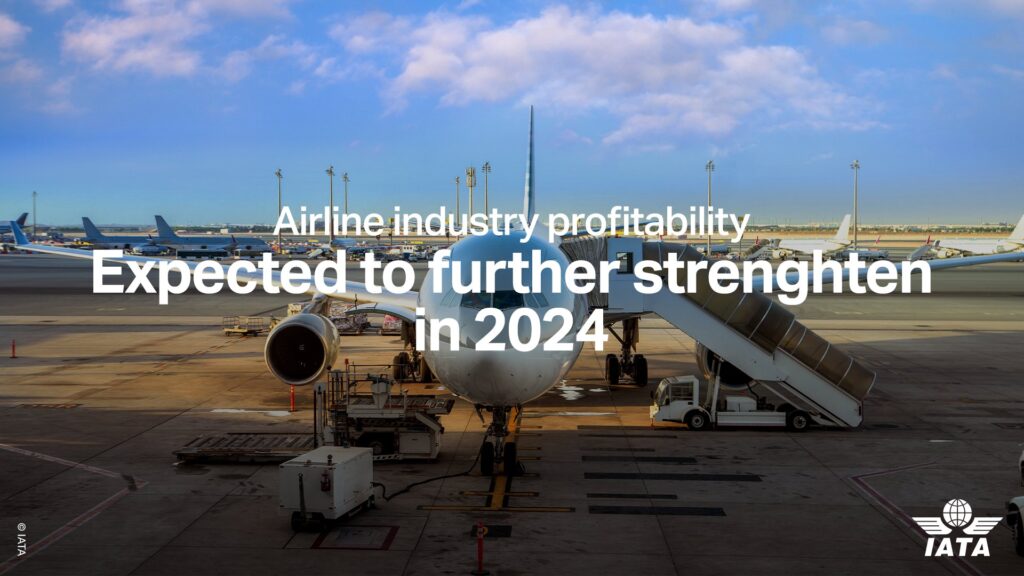
globalbizmag.com
Global Airlines’ Revenue Projected to Reach $996 Billion in 2024
The global airline industry’s revenue is projected to reach $996 billion in 2024, marking 9.7% y-o-y growth and reaching the highest nominal value in aviation history, just shy of the evocative threshold of $1 trillion, International Air Transport Association (IATA) said.
In its latest report on Global outlook for Air Transport, which was released at ity annual general meeting held in Dubai on Monday, IATA said that the revenue growth will stem chiefly from an increase in traffic, as we expect that any gain in passenger yields will be offset by a decline in cargo yields. Therefore, overall revenue per Available Tonne-Kilometer (ATK) should remain flat compared with 2023.
However, the industry has demonstrated a remarkable ability to adapt to the changing market environment. In 2023, revenues exceeded the 2019 level, and operating profits rebounded to a level last seen in 2018 despite the relatively high crude oil prices, the strong USD against many other currencies, persistent inflation, as well as the higher interest rates, IATA said in the report.
“Thanks to higher than anticipated yields, we have revised up our 2023 profits forecast for all regions, most notably in Asia Pacific, Latin America, and Europe. At the industry level, we now expect 2023 net profit stands to reach $27.4 billion and the current operating margin should climb to 5.7%,” IATA said.

Profits Soar for Middle East
The Middle East carriers are estimated to have delivered a strong financial performance in 2023, likely recording a net profit of around $3.1 billion, coupled with a 4.9% net profit margin.
The region’s financial recovery benefits from still significant RPK growth that reached 32.3% YoY in 2023 and should post a healthy 9.3% y-o-y in 2024. A net profit of around $3.8 billion at a 5.3% net profit margin is expected in 2024.
The Middle East carriers enjoy buoyant economic performance in the region, and they operate important global hubs, especially the UAE continues to attract business and leisure travellers, the report said.
Saudi Arabia’s massive investments in infrastructure and tourism are bearing fruit and the country is witnessing robust growth in passenger and cargo volumes. While airlines continue to add capacity, yields and demand remain healthy and look set to continue apace.
Geopolitical risks are the main threat, especially to the carriers in the Levant region. The Gulf carriers are relatively less impacted unless tensions between Iran and Israel escalate.
Traffic to Grow
In 2024, IATA expects further growth in traffic, though at a slower pace than that seen in 2022 and 2023. This should allow net profits for the aviation industry to reach $30.5 billion, with a 3.1% net profit margin and a 6% operating margin.
The operating margin is expected to continue its upward trend, driven by sustained demand and further gains in fleet utilisation and load factors. These factors should help dilute the unit cost specifically, the non-fuel unit cost measured per ATK and boost the profit margin.
Delays in Aircraft Deliveries
Delays in aircraft deliveries can have contrasting effects on airlines and their network. On the one hand, limited seat availability may prevent the maximisation of anticipated revenue growth. On the other hand, delays can enhance profitability if higher load factors lead to higher yields, potentially improving margins.
High interest rates tend to have a negative impact on net margins and typically impact airlines’ financing costs with a lag. The full effect of the tighter monetary policy is likely to be felt in 2024 and 2025. Furthermore, delays in aircraft deliveries have already driven operating lease prices to record highs, which could also impact profitability this year.
Despite these challenges, IATA expects that 2024 will see a relatively stable macro-economic outlook and strong passenger demand. These factors should enable the airline industry to improve its operating margin compared to 2023.
The improved financial health can also be observed on the balance sheets. First reads of industry financials this year indicate nominal debt levels falling to a level just a notch above 2019 and a rough estimate of adjusted net debt/EBITDAR ratio of 4.1x compared with 2017-19 average of 4x.
On the other hand, debt levels now imply higher interest burdens, given a sharp increase in interest rate, which may put pressure on net margins, IATA said.















